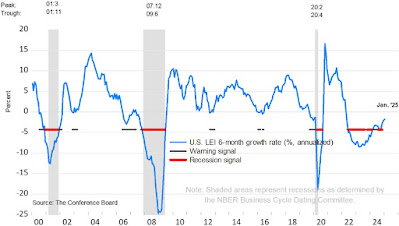Leading Economic Index for SEPTEMBER 2025
Index for September 2025: 98.3 (The baseline 100 score is associated with 2016 data.)
==============
Predicted: -0.3%
- Actual: -0.3% (-0.3 point Month-on-Month)
- Change from 12 Months Ago: -3.34% (-3.4 points)
==============
- LEI for August 2025: 98.6
- LEI for July 2025: 98.9
- LEI for June 2025: 98.9
- LEI for May 2025: 99.1
- LEI for April 2025: 99.1
- LEI for March 2025: 100.4
- LEI for February 2025: 101.2
- LEI for January 2025: 101.4
- LEI for December 2024: 101.6
- LEI for November 2024: 101.7
- LEI for October 2024: 101.4
- LEI for September 2024: 101.7
The yellow-highlighted percentage is the month-to-month change for the index. The "predicted" figure is what economists were expecting, while the "actual" is the true or real figure.
The LEI is a composite of 10 of the nation's economic data releases that's put together by The Conference Board. Statistically, the components listed below have shown a significant increase or decrease before national economic upturns or downturns:
- The Standard + Poor's 500 Index
- Average weekly claims for unemployment insurance
- Building permits for new private housing
- The interest rate spread between the yield on the benchmark 10-Year Treasury Note and Federal Funds
- ISM® Index of New Orders
- Manufacturer's new orders for consumer goods or materials
- Manufacturer's new orders, non-defense capital goods excluding aircraft orders
- Average weekly manufacturing hours
- Average consumer expectations for business conditions
- Leading Credit Index™
6-Month Growth Rate
with Warning + Recession Signal
SEPTEMBER 2025 UPDATE
"...'The US LEI fell again in September, marking a second consecutive decline,' said Justyna Zabinska-La Monica, Senior Manager, Business Cycle Indicators, at The Conference Board.
'Weakening expectations from consumers and businesses led the overall contraction in the Index. Subindexes that contributed negatively to the LEI were consumer expectations and ISM® New Orders Index, followed by manufacturers' new orders of consumer goods & materials, initial claims for unemployment Insurance (inverted), and the yield curve.
However, stock prices, the Leading Credit Index, and manufacturers' new orders of nondefense capital goods excluding aircraft did contribute positively to the Index. The LEI suggests slowing economic activity at the end of 2025 and into early 2026, with GDP weakening after strong mid-year consumer spending and Q4 disruptions amid the federal government shutdown.
Overall, growth remains fragile and uneven as businesses adjust to tariff changes and softer consumer momentum. The Conference Board expects GDP to expand by 1.8% in 2025, before falling to 1.5% in 2026.'..."
Labels: consumer, consumers, disinflation, Economy, FedPrimeRate, FedPrimeRate.com, inflation, Leading_Economic_Index, leading_economic_indicators, Recession_Risk, Recession_Signals, Recession_Warning, tariffs, Trump_Tariffs
|
--> www.FedPrimeRate.com Privacy Policy <--
CLICK HERE to JUMP to the TOP of THIS PAGE > SITEMAP < |











